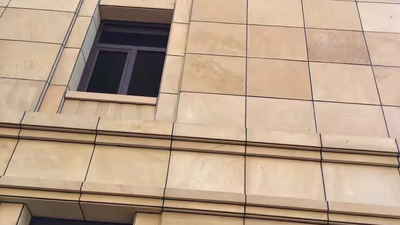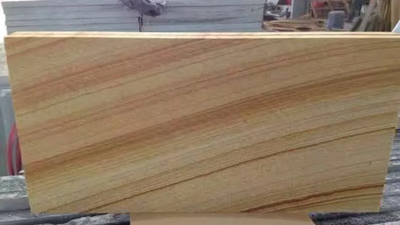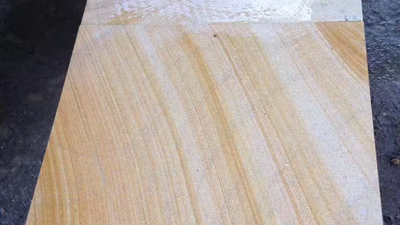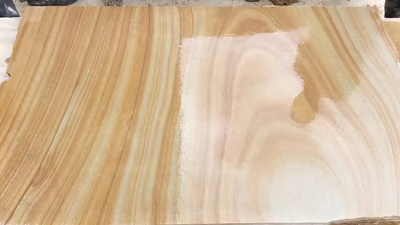
Sandstone slabs showcase natural beauty and durability in design.
Sandstone offers natural beauty and a wide range of colors and textures. Its unique patterns and variations make each slab distinct and visually appealing. The warm tones, earthy hues, and natural grain of sandstone can enhance the aesthetic appeal of any space, be it indoor or outdoor. Sandstone slabs can be used in a variety of applications. They are commonly employed as countertops, flooring, wall cladding, paving stones, and decorative features. Sandstone's versatility allows it to blend well with different architectural styles and design themes, from rustic to contemporary.
Sandstone has excellent thermal insulation properties, which means it can retain heat and stay relatively cool in warm climates. This feature makes it a popular choice for outdoor applications, such as patios and pool areas, where walking on a cool surface is desirable. Sandstone is a widely available natural resource in many parts of the world, including various regions of Asia, Europe, North America, and Australia. This availability makes it more accessible and affordable compared to some other types of stone slabs.
Sandstone is a natural and sustainable material, as it is quarried from the earth without the need for extensive processing. It is a renewable resource, and its use as a building material can contribute to environmentally friendly construction practices. Sandstone is sheetrock that is composed of minerals the size of sand and in the form of quartz and feldspar. This type of laminate is available in different colors. Sandstones are very resistant to weathering and weathering. This type of stone is used in construction and paving. Sandstone is also used to sharpen knives. Another application is the construction of railways and roads. This type of stone is also very useful in making other tools.
An important feature of these stones is weather resistance. This feature in laminate has led to its use in construction and paving. These stones are very strong and can withstand heavyweights. The beautiful and attractive colors of these stones are stunning and are widely used in various industries such as construction and tool making.
They are generally resistant to frost. Their final surface can be used as hammers, chisels, and axes, and non-ferrous tools are used to install them. Some features are consist of weather-resistant, high water absorption, high flexural strength, price is right, different color combinations, resistance to temperature changes. Sand deposits that are bonded together by calcium carbonate, silica, iron oxide, and dolomite are called limestone, silica, iron oxide, and dolomite sandstones, respectively. Depending on the nature of the early sedimentary sand, sandstones may have a soft or coarse texture. In terms of color, based on the adhesive, they range from white, pea, and gray to brown and red.
Well-cemented sandstone is known for its strength and durability. It can withstand heavy loads, making it suitable for high-traffic areas. Sandstone is also resistant to weathering, which means it can withstand the effects of exposure to the elements and retain its appearance over time. Sandstone is relatively low-maintenance compared to some other natural stones. It is resistant to staining, and regular cleaning with mild soap and water is usually sufficient to keep it looking clean and beautiful. Sealing the surface can further enhance its stain resistance and longevity.
-

Sandstone is a versatile building material known for its durability, aesthetic appeal, and strength, making it suitable for various applications. It is commonly used in facades, walls, flooring, landscaping projects, and outdoor spaces such as pathways and patios. Its thermal properties also make it ideal for fireplace surrounds. However, sandstone has limitations due to its high porosity and water absorption. It is unsuitable for areas exposed to moisture or acidic environments, such as bathrooms or industrial settings. Additionally, sandstone may not withstand heavy loads or extreme weather conditions like freeze-thaw cycles. While it can be used for countertops, it requires regular maintenance to prevent damage from scratching and staining. Overall, understanding the appropriate uses of sandstone is crucial for maximizing its benefits while avoiding potential issues.
-

Sandstone is a versatile natural stone known for its aesthetic appeal and durability. Its unique patterns and warm tones make it suitable for various applications, including countertops, flooring, wall cladding, and outdoor spaces. The material"s excellent thermal insulation properties allow it to remain cool in warm climates, making it ideal for patios and pool areas. Sandstone is widely available across the globe, particularly in regions of Asia, which contributes to its affordability compared to other stone types. As a sustainable resource, sandstone is quarried with minimal processing, promoting environmentally friendly construction practices. Its resistance to weathering and heavy loads makes it suitable for high-traffic areas. Additionally, sandstone requires low maintenance; regular cleaning with mild soap suffices to maintain its appearance. Sealing can enhance its longevity and stain resistance.
The diverse color range of sandstone—from white to red—adds to its appeal in both construction and decorative applications. "
-

Sandstone forms in diverse environments such as deserts, riverbeds, and marine settings, influenced by sediment sources and weathering processes. Its mineral composition includes quartz, feldspar, and clay minerals, which determine its characteristics. Various types of sandstone exist: Quartz Sandstone is durable and light-colored; Arkose contains feldspar and has a reddish hue; Greywacke is dark and mixed with rock fragments; Cross-bedded sandstone features inclined layers from sand dune migration; Tuffaceous sandstone includes volcanic ash. Other types include Calcareous Sandstone, which crumbles in acidic conditions; Siliceous Sandstone, stable in acid; Iron Oxide Sandstone with brown to red colors; and Dolomite Sandstone, which is less resistant in urban areas. Weathering and erosion significantly affect sandstone"s composition over geological time scales. Environmental changes can lead to the formation of different sandstone types at various periods. Red sandstone is known for its reddish hue due to iron oxide, while white sandstone is light-colored and often used in construction. Brown sandstone has a warm appearance enriched with iron oxides.
Diagenesis involves physical and chemical changes during sediment transformation into rock, influenced by factors like temperature and pressure. Tectonic forces also contribute to the diversity of sandstone types by altering sedimentary environments. "
-

Sandstone is a sedimentary rock primarily made of sand-sized mineral particles, predominantly quartz. It forms through the compaction and cementation of sand grains over time. Sandstone is widely utilized in construction due to its durability and aesthetic appeal, serving as a building material for walls, floors, and facades. Its color varies significantly based on mineral content, ranging from white and beige to red and brown. Notable sandstone formations include the Grand Canyon and Petra"s temples. The rock"s texture can be fine- to coarse-grained, with distinct layers reflecting sediment deposition. The cementing material, which can include silica or calcium carbonate, influences the rock"s strength and appearance. Sandstone"s weather-resistant properties make it suitable for outdoor applications, while its ease of shaping allows for diverse architectural uses.
Additionally, its hardness makes it effective for sharpening tools. Overall, sandstone"s versatility in construction and historical significance as a material highlight its importance in various industries. "
-

Sandstone formation in West Asia is influenced by various depositional environments, particularly deserts and ancient river systems. The process begins with the accumulation of loose sand grains, which undergo compaction and lithification to become solid rock. Cementation, involving minerals like silica and calcium carbonate, plays a crucial role in binding the grains together. Notable sandstone formations can be found in locations such as Petra, Wadi Rum, and the Al Hajar Mountains. These areas showcase stunning geological features that attract tourists and filmmakers alike. Sandstone"s permeability makes it valuable for water retention and filtration, contributing to its significance as a watershed. The composition of sandstone varies based on its distance from the source rock, with geological processes like erosion and tectonic activity further shaping these formations over time. Understanding these dynamics is essential for businesses engaged in commodity trade and supply chain solutions within the region. "
-

Sandstone is a sedimentary rock primarily composed of sand-sized grains, predominantly quartz, which provides its hardness and durability. The texture of sandstone varies from fine to coarse-grained, influenced by sorting and compaction. Its color spectrum ranges from tan to red, determined by mineral content and impurities like iron oxide. Sandstone is susceptible to both mechanical and chemical weathering, leading to unique landforms over time. Its workability makes it a favored material for construction and decorative applications, including walls, ceilings, and flooring. Sandstone"s thermal conductivity allows it to retain heat effectively, making it suitable for fireplaces and thermal storage systems. With a low water absorption rate of 1. 5 to 6%, sandstone is often used in outdoor settings such as patios and pool areas.
It can be categorized into four types based on its composition: clay sandstone, calcareous sandstone, siliceous sandstone, and quartzite. Notable structures made from sandstone include the White House and the Taj Mahal. The rock"s porosity varies significantly; high-porosity sandstones can be permeable, facilitating fluid movement essential for groundwater flow and oil reservoirs. Overall, the strength and durability of sandstone depend on its grain size, cementation level, and mineral makeup.






